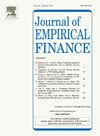Forecasting realized betas using predictors indicating structural breaks and asymmetric risk effects
IF 2.4
2区 经济学
Q2 BUSINESS, FINANCE
引用次数: 0
Abstract
This paper studies the importance of structural breaks and asymmetric risk effects for accurate forecasts of the realized beta. Specifically, structural breaks in the realized beta are detected by Iterated Cumulative Sum of Square (ICSS) algorithm and asymmetric risk effects are captured by decomposing the realized beta further into various components following Ang et al. (2006) and Bollerslev et al. (2021). We propose a set of Heterogeneous Autoregressive (HAR) model variants by incorporating these new predictors. To achieve model parsimony and to keep only the predictors with significant power, we employ Least Absolute Shrinkage and Selection Operator (LASSO) method for variable selection. Our proposed LASSO![]() HAR model with estimators of structural breaks and asymmetric risk effects is found to yield more accurate out-of-sample beta forecasts than a variety of alternative models in terms of both statistical and economic criteria. In particular, our model successfully achieves the long-memory feature of realized betas in a tractable and parsimonious way. These empirical findings are robust across different data sampling frequencies, different estimation windows, different sub-samples, different quantiles of the beta distribution and different industrial sectors.
HAR model with estimators of structural breaks and asymmetric risk effects is found to yield more accurate out-of-sample beta forecasts than a variety of alternative models in terms of both statistical and economic criteria. In particular, our model successfully achieves the long-memory feature of realized betas in a tractable and parsimonious way. These empirical findings are robust across different data sampling frequencies, different estimation windows, different sub-samples, different quantiles of the beta distribution and different industrial sectors.
预测使用表明结构性断裂和不对称风险效应的预测因子来实现贝塔
本文研究了结构断裂和不对称风险效应对准确预测已实现贝塔的重要性。具体而言,通过迭代累积平方和(ICSS)算法检测已实现贝塔的结构断裂,并根据Ang等人(2006)和Bollerslev等人(2021)将已实现贝塔进一步分解为各个分量来捕获不对称风险效应。我们提出了一组异质自回归(HAR)模型变体,结合这些新的预测因子。为了实现模型的简约性并只保留具有显著功率的预测因子,我们采用最小绝对收缩和选择算子(LASSO)方法进行变量选择。我们提出的LASSOHAR模型具有结构断裂和不对称风险效应的估计器,在统计和经济标准方面,比各种替代模型产生更准确的样本外beta预测。特别是,我们的模型以一种易于处理和简洁的方式成功地实现了已实现的beta的长记忆特征。这些实证结果在不同的数据采样频率、不同的估计窗口、不同的子样本、beta分布的不同分位数和不同的工业部门中都是稳健的。
本文章由计算机程序翻译,如有差异,请以英文原文为准。
求助全文
约1分钟内获得全文
求助全文
来源期刊

Journal of Empirical Finance
Multiple-
CiteScore
3.40
自引率
3.80%
发文量
59
期刊介绍:
The Journal of Empirical Finance is a financial economics journal whose aim is to publish high quality articles in empirical finance. Empirical finance is interpreted broadly to include any type of empirical work in financial economics, financial econometrics, and also theoretical work with clear empirical implications, even when there is no empirical analysis. The Journal welcomes articles in all fields of finance, such as asset pricing, corporate finance, financial econometrics, banking, international finance, microstructure, behavioural finance, etc. The Editorial Team is willing to take risks on innovative research, controversial papers, and unusual approaches. We are also particularly interested in work produced by young scholars. The composition of the editorial board reflects such goals.
 求助内容:
求助内容: 应助结果提醒方式:
应助结果提醒方式:


